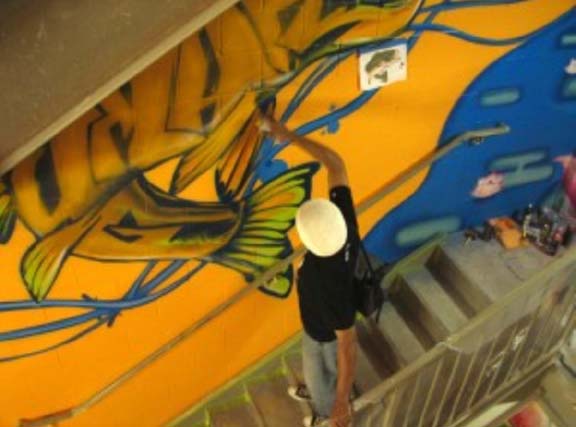From Chaos to Community: The Art and Aesthetics of Hip Hop
Justin Schell reports on a discussion held June 14 at the Walker Art Center, with Jeff Chang (author of Cant Stop Wont Stop and Total Chaos), Roger Cummings of Juxtaposition Arts, and Rachel Ramist, a scholar of hip hop.


The recent collection of essays, Total Chaos: The Art and Aesthetics of Hip Hop, edited by Jeff Chang, attempts to re-center hip hop as an entire artistic movement, encompassing not only the four original elements of MCing, DJing, graffiti writing, and b-boying/b-girling, but the art’s expansion into theater, literature, dance, and many others. Such a move counters the telescoped definition that hip hop is only rap music.
Chang, the author of the critically acclaimed Can’t Stop, Won’t Stop: A History of the Hip-Hop Generation as well as an organizer of the first National Hip-Hop Political Convention in 2004, has organized a number of panel discussions throughout the country following the publication of Total Chaos. These are not simple book signings: for each panel, Chang brings together some of the most important figures in hip hop today.
For the panel held last week at the Walker Art Center (click here for the Walker Channel panel discussion), Chang included two Twin Cities hip hop figures: Roger Cummings, co-founder of North Minneapolis’s Juxtaposition Arts and one of the Twin Cities’ earliest graffiti writers, and Rachel Ramist, a graduate student at the University of Minnesota’s Gender, Women, and Sexuality Studies program. Ramist and Cummings, however, were not simply local flavor: In addition to working for most of the major hip hop record labels and magazines, Ramist created one of the best films to examine women in hip hop, Nobody Knows My Name, and has chronicled the spread of hip hop in South America. Cummings’ Juxtaposition Arts is a nationally recognized center that uses hip hop within a community to foster urban youth creativity. Rounding out the panel was Cey Adams, a legendary graphic designer whose work can be seen on magazines, record covers, and various TV shows.
The wide-ranging discussion brought up many of the most pressing issues facing not only hip hop, but the world in which hip hop and its practioners live. The larger question of aesthetics faded as the discussion progressed, most of it focused around the contemporary relevance of hip hop as a source of social change. An overall point that the panelists all agreed on was that a focus on individual artists and commodities only serves to limit the possibilities of hip hop, and often can feed into the limited notions of hip hop’s cultural identity. Rather, focusing on institutions and communities made any talk of hip hop’s cyclical death and rebirth—the latest coming with Nas’s recent album Hip Hop Is Dead—wrong-headed and perhaps even irrelevant. It also shows the many positive ways that hip hop is used in a community, stories not discussed when speaking about hip hop on the national level.
The discussion also veered towards two of the more problematic discourses in hip hop: that of a crude distinction between “mainstream” and “underground” hip hop as well as the discourse of “realness” that serves as a marker of authenticity. Any discussion of the “intangibles” of hip hop, which were often brought up by the audience, has the potential to slip into gnarled debates of authenticity that have no right answer and often distract from hip hop’s social potential. Audience members also invoked the vague conception of “mainstream” rap music, as opposed to a somehow autonomous underground hip hop sphere.
Ramist and Cummings provided nuanced responses to both. Ramist’s argued that we cannot completely dismiss Bay Area rapper Too $hort for his trafficking of the worst mainstream stereotypes concerning women in hip hop. His songs like “The Ghetto” paint a stark portrayal of life in the economically desperate inner city. It is contradictions such as these, especially the cultural conditions that give rise to those contradictions, that need to be interrogated and critiqued rather than continuing to put forth simplistic binaries. Similarly, seeking to shift lyrical perspectives from “real” to realistic, Cummings challenged artists to paint a more accurate lyrical picture of life, leaving behind the ghetto superstar fantasies of selling drugs, drinking Crystal, and pimping women. Both of these sentiments are nothing new, but current conceptions of hip hop necessitate their repetition.
It was more than appropriate to have this discussion in Minneapolis. Beyond the phenomenally broad hip hop music scene here in the Cities, with numerous artists, record labels, and shows happening almost every night of the week, there is a substantial community-oriented presence within Twin Cities hip hop. Two examples are the annual B-Girl Be summit, which celebrates the place of women in hip hop with artists from all over the world, and is the only event of its kind in the world, as well as the hip hop-oriented classes at the non-profit Hope Community, Inc. center, located in the Philips neighborhood of Minneapolis. In an area where the only all-rap station exclaims at every turn “We Are Hip Hop,” the discussion at the Walker, as well as the larger Twin Cities hip hop scene, showed just how much more hip hop can be.